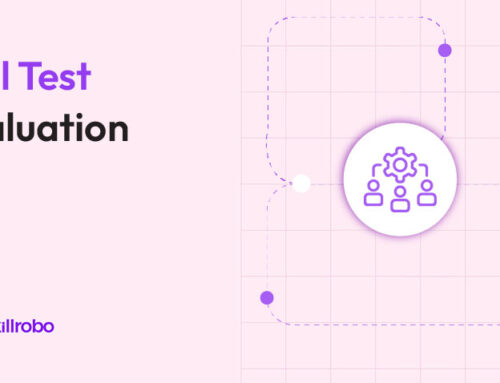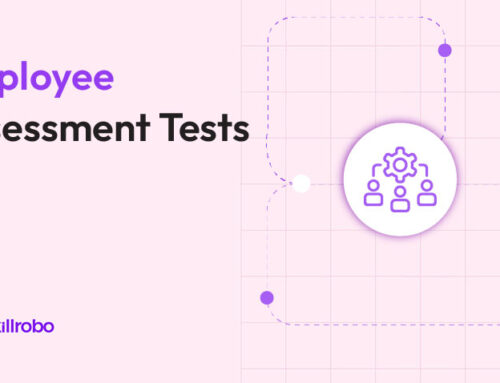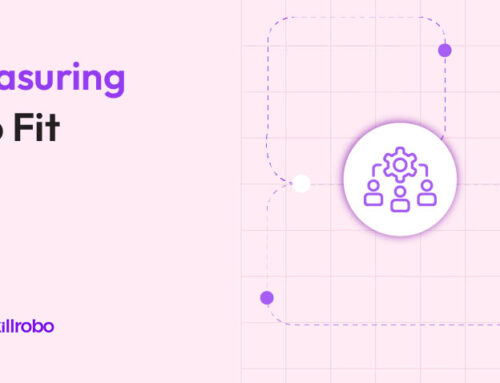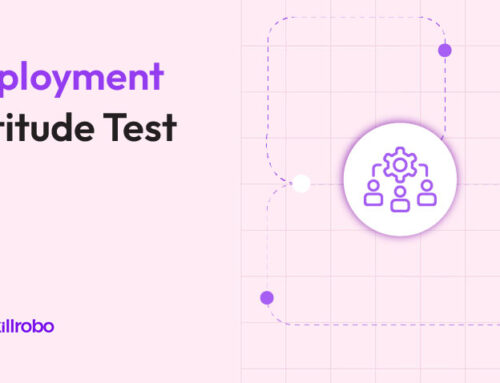Table of Contents
- Key Takeaways
- Understanding the Numerical Aptitude Test
- Types of Numerical Aptitude Tests
- Why Employers Use Numerical Aptitude Tests
- How to Prepare for a Numerical Aptitude Test
- Extra Value: Solutions that Support Numerical Assessment
- Common Challenges Faced by Candidates
- Why Skillrobo Is Ideal for Numerical Assessments
- Conclusion
- Frequently Asked Questions
Related articles
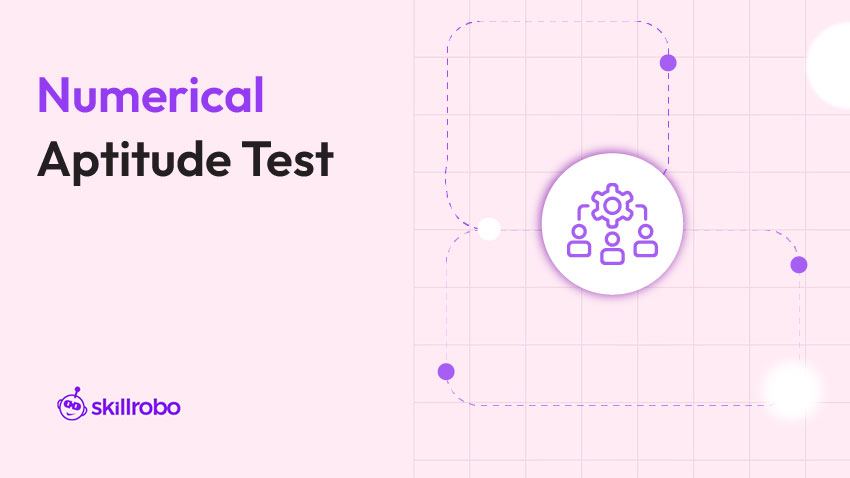
Key Takeaways
- A numerical aptitude test measures how effectively a candidate can work with numbers, graphs, ratios, and data.
- Employers use numerical aptitude tests to assess job readiness, especially for roles in finance, tech, and operations.
- Practicing with real numerical aptitude test examples can significantly improve test confidence and performance.
- Online platforms now offer customizable numerical ability aptitude tests with adaptive difficulty and real-time scoring.
Understanding the Numerical Aptitude Test
A numerical aptitude test is a standardized assessment designed to evaluate a person’s ability to interpret, analyze, and draw conclusions from numerical information. These tests are commonly used in pre-employment screenings, particularly for roles that require analytical thinking and quantitative skills.
Whether you’re applying for a job in banking, consulting, engineering, or logistics, numerical tests are a vital part of the hiring process. These tests often involve interpreting tables, solving word problems, performing percentage calculations, and working with ratios or currency conversions.
According to Aptitude-Test.com, numerical tests are designed to assess both speed and accuracy. Candidates are often required to complete each question within 60–90 seconds, which makes preparation and strategy essential.
Types of Numerical Aptitude Tests
Numerical aptitude tests come in various formats depending on the role, industry, and skill level being assessed. Employers often tailor these tests to align with the cognitive demands of a specific job. By selecting the right type of test, organizations can accurately measure not just mathematical ability, but also decision-making and problem-solving potential. These tests are also increasingly used in talent development assessment programs to identify skill gaps and tailor upskilling initiatives.
1. Basic Arithmetic Tests
These tests assess core math functions, including addition, subtraction, multiplication, and division. They’re commonly used for entry-level or clerical roles, as well as in sectors like manufacturing and logistics where basic calculations are routine. While simple in structure, speed and accuracy remain critical.
2. Data Interpretation Tests
Candidates are presented with tables, graphs, or charts and asked to analyze trends, calculate ratios, or draw conclusions. This type of test is especially relevant in business analysis, supply chain, and financial services, where interpreting visual data is a daily task.
3. Word Problems
These questions simulate real-life scenarios—like calculating discounts, tax, or budget splits—and require candidates to apply arithmetic in a practical context. Word problems are often used in customer service, retail, and hospitality roles to test functional numeracy in decision-making.
4. Advanced Numerical Reasoning Tests
Designed for more strategic roles, these tests present complex datasets and require test-takers to identify trends, apply logic, and solve multi-step problems under time pressure. Often used in consulting, tech, and managerial hiring, they assess critical thinking as much as numerical skills.
These varied test types not only help with candidate screening but also form part of ongoing talent development assessment strategies, ensuring employees are equipped with the quantitative skills required to grow into more advanced roles.
Why Employers Use Numerical Aptitude Tests
Employers use numerical aptitude tests to identify candidates with strong quantitative reasoning and problem-solving capabilities. These skills are critical in fast-paced, data-centric roles where decisions must be made quickly and accurately.
Using these tests helps reduce bias in the hiring process by evaluating all candidates against the same objective standard. It also helps predict job performance and trainability, particularly for roles involving budgets, forecasting, or performance metrics.
Online numerical reasoning aptitude test platforms now allow for scalable testing with built-in analytics, reducing manual screening effort for recruiters.
How to Prepare for a Numerical Aptitude Test
Success in a numerical aptitude test is not just about knowing math—it’s about applying it efficiently under pressure. These tests are designed to assess how well candidates can interpret data, perform calculations, and make decisions within tight time limits. With proper preparation, you can significantly improve both your confidence and performance. Here are five essential steps to help you get ready:
1. Understand the Format
Begin by reviewing the structure of the test you’ll be taking. Numerical aptitude tests can include questions on percentages, ratios, graphs, tables, currency conversions, and algebra. Each test provider—such as SHL, Kenexa, or Talent Q—may use a slightly different format. Understanding the question style and structure ensures you’re not caught off guard on test day.
2. Practice Timed Tests
Time is one of the biggest challenges in numerical tests. Practicing under timed conditions helps improve your mental agility and trains you to work efficiently. Many platforms offer mock tests that simulate real test environments, helping you build endurance and pace.
3. Review Mistakes
Don’t just practice—analyze your errors. Go back to the questions you got wrong and identify where you made mistakes. Was it a miscalculation, a misread question, or a timing issue? Reviewing helps reinforce concepts and prevents repeated errors, sharpening both accuracy and strategy.
4. Use Online Resources
These platforms offer free and paid numerical aptitude test examples, including answer explanations and difficulty-level breakdowns. Practice across various formats to build familiarity and reduce anxiety.
5. Focus on Weak Areas
Identify your weakest topics—whether it’s percentages, data interpretation, or multi-step word problems—and devote extra time to them. Targeted practice leads to faster improvement and greater overall test readiness. It’s also an efficient way to make the most of limited prep time.
With the right approach, even candidates with basic math skills can excel in numerical tests. Structured preparation builds confidence, improves accuracy, and gives you a real edge in data-driven recruitment processes.
Extra Value: Solutions that Support Numerical Assessment
Modern hiring processes are increasingly supported by intelligent tools that enhance how numerical aptitude tests are administered, analyzed, and linked to workforce development. These tools do more than screen candidates—they help organizations unlock deeper insights about skill levels, readiness, and growth potential. Here are some of the most valuable tools that support numerical assessment in hiring and training:
1. Skill Mapping Tools
Skill mapping tools align test outcomes with job-specific competencies. By mapping numerical test scores to actual job functions, employers can identify whether a candidate’s strengths match the performance expectations of a given role.
2. Talent Development Assessment Platforms
Talent development assessment platforms go beyond hiring by using test data to inform long-term employee development. They help track progress over time and build personalized training roadmaps based on assessment performance.
3. Aptitude Test Engines
Purpose-built engines provide features such as auto-scoring, adaptive question delivery, question randomization, and benchmarking. This ensures test reliability, fairness, and scalability, especially for large-volume hiring processes.
4. Skills Audit Tools
Skills audit tools evaluate current workforce skills against organizational needs. Based on numerical aptitude test performance, they help identify where skill gaps exist and where upskilling is required.
5. Training Needs Analysis
Training needs analysis test results feed directly into structured training recommendations. For instance, candidates who struggle with percentage-based problems may be directed to refresher modules in financial math or logical reasoning.
6. Talent Mobility Frameworks
High-performing individuals identified through talent mobility assessments can be matched to future opportunities across departments. This supports internal hiring, succession planning, and employee retention strategies.
7. Employee Talent Assessment Systems
Employee talent assessment systems consolidate various assessments—cognitive, behavioral, and numerical—into one dashboard for comprehensive employee profiling. This unified view supports more accurate hiring, development, and leadership planning.
8. Skill Assessment Dashboards
Real-time dashboards of skill assessment provide recruiters and L&D teams with immediate insights into candidate and employee performance. These dashboards track trends, flag high-potential individuals, and assist in data-driven decision-making.
Many of these tools integrate seamlessly with applicant tracking systems (ATS) and learning management systems (LMS), enabling smoother workflows and more consistent evaluation across the talent lifecycle.
Common Challenges Faced by Candidates
While numerical aptitude tests are effective tools for evaluating critical thinking and data interpretation, they can also present significant hurdles for candidates, especially when unprepared. Understanding these challenges is key to helping test-takers perform at their best and reducing assessment-related stress.
1. Time Pressure
Most numerical tests are time-bound, requiring quick thinking under strict deadlines. Candidates often struggle to balance speed with accuracy, especially when questions involve multi-step calculations or interpretation of visual data.
2. Complex Word Problems
These problems embed numerical data within real-world contexts, making them harder to solve than straightforward calculations. Candidates must extract the right information, determine what’s being asked, and apply correct formulas—all within seconds.
3. Data Overload
Questions featuring complex graphs, multiple tables, or dense paragraphs can be overwhelming. Without regular practice, candidates may freeze or skip over questions, leading to lower scores and reduced confidence.
4. Anxiety and Mental Blocks
High-stakes testing environments can trigger anxiety, even in well-prepared candidates. This can cause mental blocks, misreading of questions, or rushed errors, particularly in the early stages of the test.
5. Inconsistent Familiarity
Candidates from different academic or professional backgrounds may not be equally comfortable with concepts like ratios, percentages, or statistical charts. A lack of recent math practice often hinders performance, even among highly capable applicants.
Overcoming these challenges requires consistent practice, familiarity with question styles, and a focus on building both speed and strategy. Employers that provide practice opportunities or prep resources before testing can help reduce anxiety and encourage fairer evaluations.
Why Skillrobo Is Ideal for Numerical Assessments
Skillrobo is a robust online assessment platform designed to simplify and streamline the testing process for hiring teams. It allows recruiters to create role-specific numerical aptitude tests with customizable question formats, secure proctoring, and instant reporting. Whether you’re evaluating entry-level candidates or experienced professionals, Skillrobo ensures each test is accurate, fair, and aligned with job requirements.
With built-in AI features, real-time analytics, and seamless ATS integration, Skillrobo supports data-driven hiring at every stage. The platform also includes preloaded test libraries and adaptive difficulty options, helping companies assess numerical reasoning skills efficiently while delivering a great candidate experience.
Conclusion
A numerical aptitude test is more than just a math quiz—it’s a powerful tool that helps employers evaluate potential and helps candidates showcase their skills. With the rise of data-driven hiring and remote assessments, these tests have become essential across industries.
For job seekers, preparation is key. Practicing with reliable numerical aptitude test examples can dramatically improve performance and reduce stress. For employers, integrating smart testing tools ensures fair, efficient, and predictive hiring.
By understanding the structure, purpose, and preparation methods, both sides can use numerical aptitude tests to make more informed decisions and improve outcomes. Sign up for Skillrobo today to streamline your assessment process and build a high-performing, data-driven hiring workflow.
Frequently Asked Questions
1. What does a numerical aptitude test measure?
A numerical aptitude test evaluates a candidate’s ability to work with numbers, interpret data, and solve quantitative problems. It typically includes questions on arithmetic, percentages, ratios, graphs, and data interpretation. Employers use these tests to assess analytical thinking and job readiness, especially in data-driven roles.
2. How can I improve my score on a numerical aptitude test?
Improvement comes with consistent practice. Focus on understanding question formats, practicing under timed conditions, and reviewing errors. Using online platforms with numerical aptitude test examples helps build familiarity and speed. Strengthening weaker areas like word problems or graph analysis, can significantly boost overall performance.
3. Are numerical aptitude tests only for finance or technical roles?
No. While common in finance, engineering, and tech, numerical aptitude tests are also used in retail, operations, customer service, and graduate hiring programs. Any role that involves data analysis, budgeting, or performance tracking may require candidates to demonstrate strong numerical reasoning skills.

Key Takeaways
- A numerical aptitude test measures how effectively a candidate can work with numbers, graphs, ratios, and data.
- Employers use numerical aptitude tests to assess job readiness, especially for roles in finance, tech, and operations.
- Practicing with real numerical aptitude test examples can significantly improve test confidence and performance.
- Online platforms now offer customizable numerical ability aptitude tests with adaptive difficulty and real-time scoring.
Understanding the Numerical Aptitude Test
A numerical aptitude test is a standardized assessment designed to evaluate a person’s ability to interpret, analyze, and draw conclusions from numerical information. These tests are commonly used in pre-employment screenings, particularly for roles that require analytical thinking and quantitative skills.
Whether you’re applying for a job in banking, consulting, engineering, or logistics, numerical tests are a vital part of the hiring process. These tests often involve interpreting tables, solving word problems, performing percentage calculations, and working with ratios or currency conversions.
According to Aptitude-Test.com, numerical tests are designed to assess both speed and accuracy. Candidates are often required to complete each question within 60–90 seconds, which makes preparation and strategy essential.
Types of Numerical Aptitude Tests
Numerical aptitude tests come in various formats depending on the role, industry, and skill level being assessed. Employers often tailor these tests to align with the cognitive demands of a specific job. By selecting the right type of test, organizations can accurately measure not just mathematical ability, but also decision-making and problem-solving potential. These tests are also increasingly used in talent development assessment programs to identify skill gaps and tailor upskilling initiatives.
1. Basic Arithmetic Tests
These tests assess core math functions, including addition, subtraction, multiplication, and division. They’re commonly used for entry-level or clerical roles, as well as in sectors like manufacturing and logistics where basic calculations are routine. While simple in structure, speed and accuracy remain critical.
2. Data Interpretation Tests
Candidates are presented with tables, graphs, or charts and asked to analyze trends, calculate ratios, or draw conclusions. This type of test is especially relevant in business analysis, supply chain, and financial services, where interpreting visual data is a daily task.
3. Word Problems
These questions simulate real-life scenarios—like calculating discounts, tax, or budget splits—and require candidates to apply arithmetic in a practical context. Word problems are often used in customer service, retail, and hospitality roles to test functional numeracy in decision-making.
4. Advanced Numerical Reasoning Tests
Designed for more strategic roles, these tests present complex datasets and require test-takers to identify trends, apply logic, and solve multi-step problems under time pressure. Often used in consulting, tech, and managerial hiring, they assess critical thinking as much as numerical skills.
These varied test types not only help with candidate screening but also form part of ongoing talent development assessment strategies, ensuring employees are equipped with the quantitative skills required to grow into more advanced roles.
Why Employers Use Numerical Aptitude Tests
Employers use numerical aptitude tests to identify candidates with strong quantitative reasoning and problem-solving capabilities. These skills are critical in fast-paced, data-centric roles where decisions must be made quickly and accurately.
Using these tests helps reduce bias in the hiring process by evaluating all candidates against the same objective standard. It also helps predict job performance and trainability, particularly for roles involving budgets, forecasting, or performance metrics.
Online numerical reasoning aptitude test platforms now allow for scalable testing with built-in analytics, reducing manual screening effort for recruiters.
How to Prepare for a Numerical Aptitude Test
Success in a numerical aptitude test is not just about knowing math—it’s about applying it efficiently under pressure. These tests are designed to assess how well candidates can interpret data, perform calculations, and make decisions within tight time limits. With proper preparation, you can significantly improve both your confidence and performance. Here are five essential steps to help you get ready:
1. Understand the Format
Begin by reviewing the structure of the test you’ll be taking. Numerical aptitude tests can include questions on percentages, ratios, graphs, tables, currency conversions, and algebra. Each test provider—such as SHL, Kenexa, or Talent Q—may use a slightly different format. Understanding the question style and structure ensures you’re not caught off guard on test day.
2. Practice Timed Tests
Time is one of the biggest challenges in numerical tests. Practicing under timed conditions helps improve your mental agility and trains you to work efficiently. Many platforms offer mock tests that simulate real test environments, helping you build endurance and pace.
3. Review Mistakes
Don’t just practice—analyze your errors. Go back to the questions you got wrong and identify where you made mistakes. Was it a miscalculation, a misread question, or a timing issue? Reviewing helps reinforce concepts and prevents repeated errors, sharpening both accuracy and strategy.
4. Use Online Resources
These platforms offer free and paid numerical aptitude test examples, including answer explanations and difficulty-level breakdowns. Practice across various formats to build familiarity and reduce anxiety.
5. Focus on Weak Areas
Identify your weakest topics—whether it’s percentages, data interpretation, or multi-step word problems—and devote extra time to them. Targeted practice leads to faster improvement and greater overall test readiness. It’s also an efficient way to make the most of limited prep time.
With the right approach, even candidates with basic math skills can excel in numerical tests. Structured preparation builds confidence, improves accuracy, and gives you a real edge in data-driven recruitment processes.
Extra Value: Solutions that Support Numerical Assessment
Modern hiring processes are increasingly supported by intelligent tools that enhance how numerical aptitude tests are administered, analyzed, and linked to workforce development. These tools do more than screen candidates—they help organizations unlock deeper insights about skill levels, readiness, and growth potential. Here are some of the most valuable tools that support numerical assessment in hiring and training:
1. Skill Mapping Tools
Skill mapping tools align test outcomes with job-specific competencies. By mapping numerical test scores to actual job functions, employers can identify whether a candidate’s strengths match the performance expectations of a given role.
2. Talent Development Assessment Platforms
Talent development assessment platforms go beyond hiring by using test data to inform long-term employee development. They help track progress over time and build personalized training roadmaps based on assessment performance.
3. Aptitude Test Engines
Purpose-built engines provide features such as auto-scoring, adaptive question delivery, question randomization, and benchmarking. This ensures test reliability, fairness, and scalability, especially for large-volume hiring processes.
4. Skills Audit Tools
Skills audit tools evaluate current workforce skills against organizational needs. Based on numerical aptitude test performance, they help identify where skill gaps exist and where upskilling is required.
5. Training Needs Analysis
Training needs analysis test results feed directly into structured training recommendations. For instance, candidates who struggle with percentage-based problems may be directed to refresher modules in financial math or logical reasoning.
6. Talent Mobility Frameworks
High-performing individuals identified through talent mobility assessments can be matched to future opportunities across departments. This supports internal hiring, succession planning, and employee retention strategies.
7. Employee Talent Assessment Systems
Employee talent assessment systems consolidate various assessments—cognitive, behavioral, and numerical—into one dashboard for comprehensive employee profiling. This unified view supports more accurate hiring, development, and leadership planning.
8. Skill Assessment Dashboards
Real-time dashboards of skill assessment provide recruiters and L&D teams with immediate insights into candidate and employee performance. These dashboards track trends, flag high-potential individuals, and assist in data-driven decision-making.
Many of these tools integrate seamlessly with applicant tracking systems (ATS) and learning management systems (LMS), enabling smoother workflows and more consistent evaluation across the talent lifecycle.
Common Challenges Faced by Candidates
While numerical aptitude tests are effective tools for evaluating critical thinking and data interpretation, they can also present significant hurdles for candidates, especially when unprepared. Understanding these challenges is key to helping test-takers perform at their best and reducing assessment-related stress.
1. Time Pressure
Most numerical tests are time-bound, requiring quick thinking under strict deadlines. Candidates often struggle to balance speed with accuracy, especially when questions involve multi-step calculations or interpretation of visual data.
2. Complex Word Problems
These problems embed numerical data within real-world contexts, making them harder to solve than straightforward calculations. Candidates must extract the right information, determine what’s being asked, and apply correct formulas—all within seconds.
3. Data Overload
Questions featuring complex graphs, multiple tables, or dense paragraphs can be overwhelming. Without regular practice, candidates may freeze or skip over questions, leading to lower scores and reduced confidence.
4. Anxiety and Mental Blocks
High-stakes testing environments can trigger anxiety, even in well-prepared candidates. This can cause mental blocks, misreading of questions, or rushed errors, particularly in the early stages of the test.
5. Inconsistent Familiarity
Candidates from different academic or professional backgrounds may not be equally comfortable with concepts like ratios, percentages, or statistical charts. A lack of recent math practice often hinders performance, even among highly capable applicants.
Overcoming these challenges requires consistent practice, familiarity with question styles, and a focus on building both speed and strategy. Employers that provide practice opportunities or prep resources before testing can help reduce anxiety and encourage fairer evaluations.
Why Skillrobo Is Ideal for Numerical Assessments
Skillrobo is a robust online assessment platform designed to simplify and streamline the testing process for hiring teams. It allows recruiters to create role-specific numerical aptitude tests with customizable question formats, secure proctoring, and instant reporting. Whether you’re evaluating entry-level candidates or experienced professionals, Skillrobo ensures each test is accurate, fair, and aligned with job requirements.
With built-in AI features, real-time analytics, and seamless ATS integration, Skillrobo supports data-driven hiring at every stage. The platform also includes preloaded test libraries and adaptive difficulty options, helping companies assess numerical reasoning skills efficiently while delivering a great candidate experience.
Conclusion
A numerical aptitude test is more than just a math quiz—it’s a powerful tool that helps employers evaluate potential and helps candidates showcase their skills. With the rise of data-driven hiring and remote assessments, these tests have become essential across industries.
For job seekers, preparation is key. Practicing with reliable numerical aptitude test examples can dramatically improve performance and reduce stress. For employers, integrating smart testing tools ensures fair, efficient, and predictive hiring.
By understanding the structure, purpose, and preparation methods, both sides can use numerical aptitude tests to make more informed decisions and improve outcomes. Sign up for Skillrobo today to streamline your assessment process and build a high-performing, data-driven hiring workflow.
Frequently Asked Questions
1. What does a numerical aptitude test measure?
A numerical aptitude test evaluates a candidate’s ability to work with numbers, interpret data, and solve quantitative problems. It typically includes questions on arithmetic, percentages, ratios, graphs, and data interpretation. Employers use these tests to assess analytical thinking and job readiness, especially in data-driven roles.
2. How can I improve my score on a numerical aptitude test?
Improvement comes with consistent practice. Focus on understanding question formats, practicing under timed conditions, and reviewing errors. Using online platforms with numerical aptitude test examples helps build familiarity and speed. Strengthening weaker areas like word problems or graph analysis, can significantly boost overall performance.
3. Are numerical aptitude tests only for finance or technical roles?
No. While common in finance, engineering, and tech, numerical aptitude tests are also used in retail, operations, customer service, and graduate hiring programs. Any role that involves data analysis, budgeting, or performance tracking may require candidates to demonstrate strong numerical reasoning skills.



